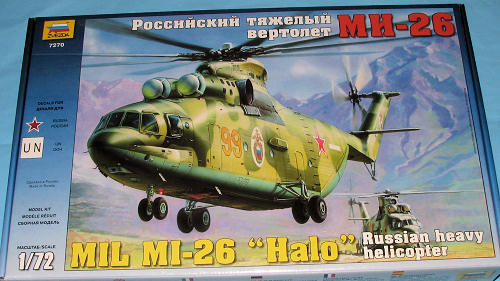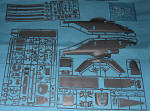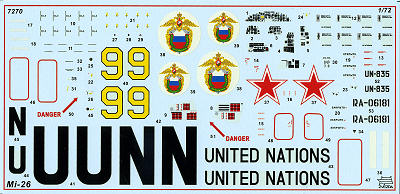
| KIT #: | 7270 |
| PRICE: | $52.00 HSSRP |
| DECALS: | One option |
| REVIEWER: | Scott Van Aken |
| NOTES: | One of the biggest 1/72 Helo kits around |

| HISTORY |
The Mi-26 was designed for military and civil use and intended to be able to lift more than any previous helicopter. The first Mi-26 flew on 14 December 1977, and the first entered service in the Soviet military in 1983.
The Mi-26 was the first helicopter to operate with an eight-blade rotor. It is capable of single-engine flight in the event of loss of power by one engine (depending on aircraft mission weight) because of an engine load sharing system.
While it is only slightly heavier than the Mil Mi-6, it can lift up to 20 tons (tonnes) (40,000 lb) - 8 tons more than Mi-6.
Common unofficial nickname of Mi-26 in Russian military is "Korova" ("Cow"). There are an impressive number of countries operating the type, though many are flying only a handful or fewer.
| THE KIT |
 This is the first kit in any scale that I can recall seeing of this large, heavy-lift Russian helo (I've been told by readers that a company called 'Southern Front' did this, but it is pretty horrible). It is truly huge and as such, though it comes in the same, large top-hinged box as several other big Zvezda kits, the fuselage halves are in two parts (main fuselage and that tail boom section). Interestingly, none of the poly bags in which the parts are located are sealed in any way. Rather unusual, but does save on tape/staples/heat sealing and the people needed to seal them.
This is the first kit in any scale that I can recall seeing of this large, heavy-lift Russian helo (I've been told by readers that a company called 'Southern Front' did this, but it is pretty horrible). It is truly huge and as such, though it comes in the same, large top-hinged box as several other big Zvezda kits, the fuselage halves are in two parts (main fuselage and that tail boom section). Interestingly, none of the poly bags in which the parts are located are sealed in any way. Rather unusual, but does save on tape/staples/heat sealing and the people needed to seal them.
The molding on the kit is first rate. As good as anything you'll find from any other to-notch company with crisply done engraved panel lines and superbly molded detail. A couple of things of note are the preformed drooped rotor blades and the fact that this kit comes with four crew members to occupy the cockpit seats.
There is a full cabin provided and you can model the helo with any or all the doors and ramps open. Zvezda includes both the cyclic and collective controls for the cockpit. There is a lot of cabin structure detail and though I noticed a few ejector pin marks in this and other places, it seems that most of them will be covered by some other detail or structure. Since the kit has a separate bottom piece in addition to the fuselage halves and the engine covers are separate, it will pay dividends to do a lot of test fitting of the major pieces to ensure a good fit. The instructions do not show a need for nose weight, but for those who like to be sure, there is room to place some if you so wish. Those who are building the kit with everything closed could probably skip several of the construction steps. The clear bits are well done, but there really isn't much to see through the cabin windows.
kit with everything closed could probably skip several of the construction steps. The clear bits are well done, but there really isn't much to see through the cabin windows.
There are markings for two aircraft. One is the box art helo from the Tajikistan border area in 1993 while the other is an all white UN version. This one will need some careful weathering as those white schemes got dirty in a big hurry. All color information is using Model Master paints, though a generic name is also provided. The big sheet is well printed and matte. Though I know of no aftermarket sheets for this (yet), doing aircraft from other countries should be relatively easy if one can come up with roundels and a few numbers to match any photo they may have.
| CONCLUSIONS |
Overall, a very fine kit and considering the size of it and the number of parts, not an unreasonable base price. Like their earlier Pe-8, I'm not sure how many will actually build this one, but it sure is a beauty and deserves to have a (large) space on your shelf.
| REFERENCES |
February 2009
My thanks to www.dragonmodelsusa.com for the preview kit. You can get this one today at your favorite shop or on-line retailer. If you would like your product reviewed fairly and fairly quickly, please contact the editor or see other details in the